News
Cancer interrupted their school lives, but also set them on a mission

At age 8 in 2009, EJ Beck hugs her favorite book, Laura Ingalls Wilder’s These Happy Golden Years. At 10, center, she is pictured in the hospital where she was treated for thyroid cancer. For Beck and her family, the Happy Golden Years image became emblematic of her life, before. At right, EJ Beck today is a 23-year-old medical student.
Beck family; José A. Alvarado Jr. for NPR
hide caption
toggle caption
Beck family; José A. Alvarado Jr. for NPR
EJ Beck was a bookish, wispy 10-year-old when a doctor found the thyroid cancer on her tiny neck that upended her life. Treatment for that cancer took Beck’s joyful school routine and replaced it with a complicated surgery, followed by a harrowing radiation treatment that made her so sick and radioactive, it required her to remain in a sealed chamber without human contact for many days.
Beck, along with her parents, had decided not to tell friends, her teachers or even her two younger sisters about her illness, hoping that might help her slip back into normal life, eventually. But in the short term, it intensified her isolation in the hospital, where she passed her solitary confinement rereading the Harry Potter series and drawing on a picture of Spiderman posted to the window.
“I was so, so jealous because Spiderman could just leave the hospital, and I couldn’t,” Beck recalls. “Spiderman got to take radiation, and he got cool powers; I got sick and sad and lonely and tired.”
Today, Beck is a 23-year-old medical student, and among a growing population of 18 million people who are surviving cancer for much longer, thanks to myriad recent advances like AI-powered tumor detection and new immunotherapies that chemically target cancers. Survival rates for pediatric cancer, in particular, are considered a crowning medical achievement: Those rates increased from 58% in the mid-1970s to 85% today.

But in order to get on with life after treatment, Beck also had to overcome many of the less-discussed aftereffects of cancer – notably the missed schooling and loss of identity and peer support that came with it, not to mention various other cognitive and physical impacts of treatment that deeply shape survivorship. Patients often feel forgotten when treatment ends, but research shows the knock-on effects, from mental health to financial challenges, can persist decades into recovery.
Out of step with peers
Today Beck is cancer-free, but says she still feels she lives in its shadow – quite literally, in the sense that her apartment is within earshot of the sirens near the New York City hospital complex where she received treatment as a child.
Also, the experience forged her into who she is, she says, and left her feeling scholastically, socially, and emotionally out of step with peers. “It takes a really long time to feel like you’re falling into sync with everybody else,” Beck says. “Even if you would make it on to college with everyone else, you kind of feel like you’re marching to a slightly different beat and you’re trying really hard to keep up.”
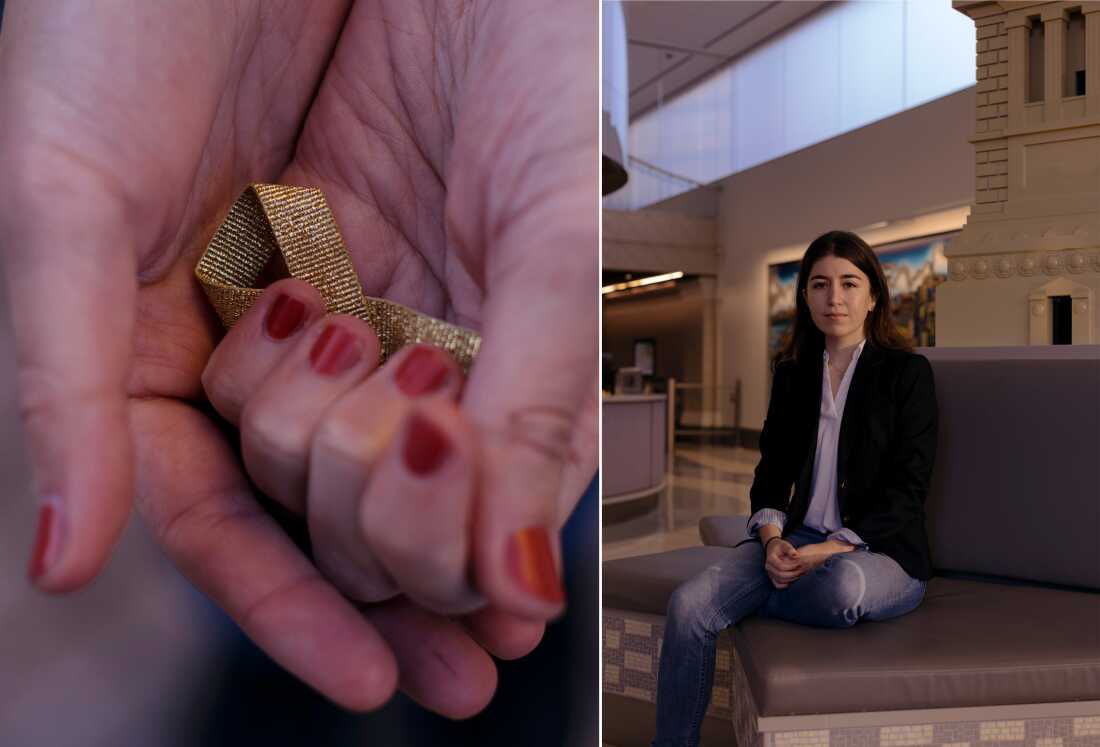
For many years, EJ Beck’s mother silently carried a golden ribbon that she received from the hospital to advocate for pediatric cancer awareness. “She passed the ribbon on to me,” says Beck, who has that ribbon hanging above her desk at home.
José A. Alvarado Jr. for NPR
hide caption
toggle caption
José A. Alvarado Jr. for NPR
When a child is diagnosed and undergoing treatment, doctors and parents tend to pour their energies – understandably – into managing the medical demands of pediatric cancer. But Julia Gomez, an education coordinator at NYU Langone Health, says for kids, the absence of the normalcy of school usually hits harder. “It’s quite devastating, to the whole child,” she says. “School is their whole world.”
With the increase in the population of survivors, there’s growing recognition that cancer care must also include planning for various aspects of life after treatment. And Gomez says more cancer centers, especially at research hospitals, are hiring education coordinators like her, who can help patients and their families stay connected to school during treatment and transition them back into their lives afterward.
Consistent support
Gomez works with some patients for up to five years, helping them and their families navigate the dizzying number of school or state bureaucracies to ensure students receive home tutoring or additional accommodations, for example. She matches them with tutors in the hospital or at home, and keeps teachers at school updated with treatment plans – tasks parents are often too overwhelmed to manage.
“I can offer myself to take on the whole academic-education-school piece,” she says.
Patient advocates argue specialized wraparound care like education coordinators should be an essential part of all pediatric and young adult cancer treatment plans. But they realistically are only accessible to a privileged minority of patients who live near the research hospitals or cancer centers that offer them.
Aside from those outside services, family engagement and support can have huge bearing on how children fare through treatment and survivorship, says Dr. Saro Armenian, director of the Childhood, Adolescent and Young Adult Survivorship Program at City of Hope Children’s Cancer Center in Los Angeles.
The more consistent, positive support a child feels from the adults and schools around them, the better they will maintain their self-worth through the grueling times, Armenian says. “The social network plays a huge role, especially as a child, when you really don’t have a guidepost for how you should behave and act in that situation.”
But even when children can remain in class or reintegrate back into school, they often feel marked by disease.
EJ Beck, for example, typically only missed morning classes through most of her treatments, but her highly restrictive, iodine-free diet meant she couldn’t eat school lunch, making her a conspicuous target for classmates. “I had this girl — I’ll never forget it,” Beck recalls, “she’d come up to me and say, ‘You’re really bullying everyone else because you’re so skinny and you’re dieting, so you’re saying that the rest of us are fat.’”
Beck swallowed her explanation to keep her cancer secret: “Once people know, they never look at you the same way.”
Still, she felt lucky, because she didn’t lose her hair — that telltale, dreaded side effect — which meant keeping cancer secret was an option for her. “I had the privilege of somebody who…cancer was never going to be as visible on me as it is on the majority of cancer patients.”
An abrupt departure from normalcy
Brendan Harley’s exit from school was far more dramatic and noticeable. On the evening of May 5, 1995 – the night before his SAT exams – Harley landed in the hospital with acute leukemia at age 17.
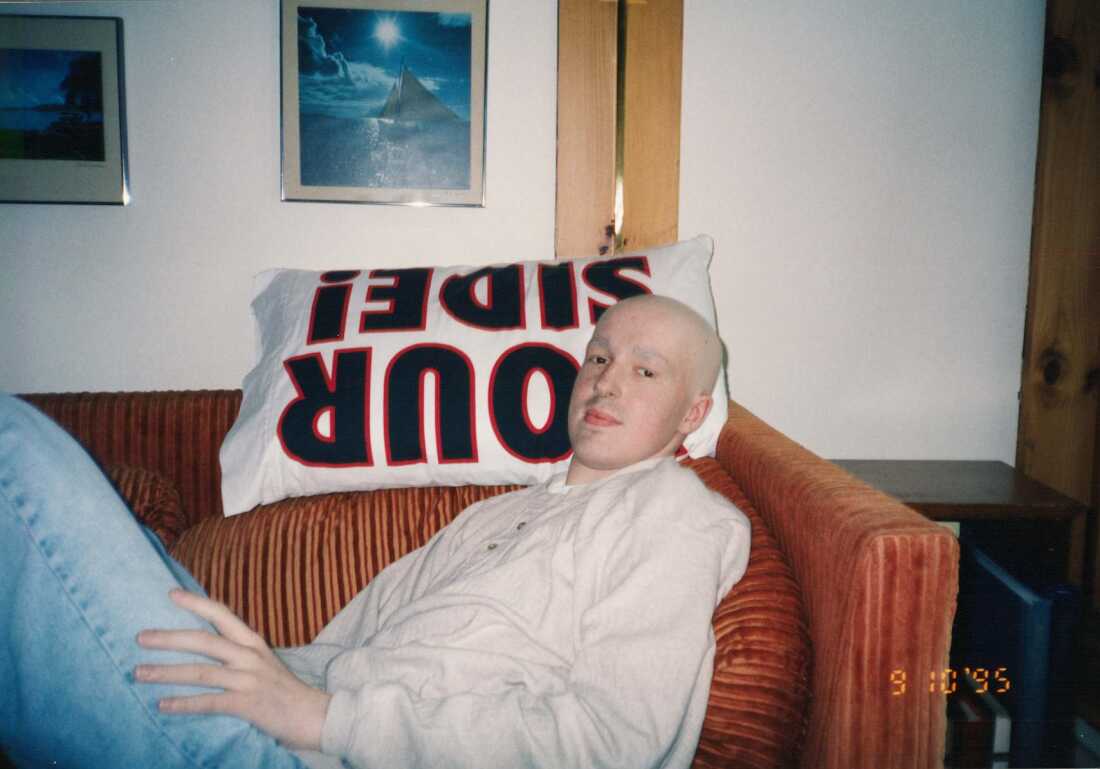
Brendan Harley home from the hospital in September 1995 after receiving a bone marrow transplant to treat his leukemia. “I was effectively living in a bubble at home,” Harley says.
Harley family
hide caption
toggle caption
Harley family
“I had to call my date for the junior prom, which was the next weekend, and say, ‘Sorry, I’m not going to be there’ – and I was then gone,” he says. He remained in the hospital, in treatment, or in isolation and away from school and friends, for a full year. Notably, this was in an era before cell phones and social media existed, so Harley’s isolation felt complete.
“I was effectively living in a bubble at home,” Harley says. His middle brother helped ferry homework to and from school. “I’d have a tutor that showed up once a week and we would set masks and gloves on different sides of the room and talk.”
It helped Harley to keep pinning his thoughts to discrete school assignments and other tasks he could control. Bald and tired, Harley studied frantically from his hospital bed, clinging to schoolwork as a handhold on life.
Often, things didn’t go to plan, as was the case with his chemistry finals: “I got out and went right to take my exams in June and I couldn’t remember any of the things I was studying because of all the chemotherapy.”
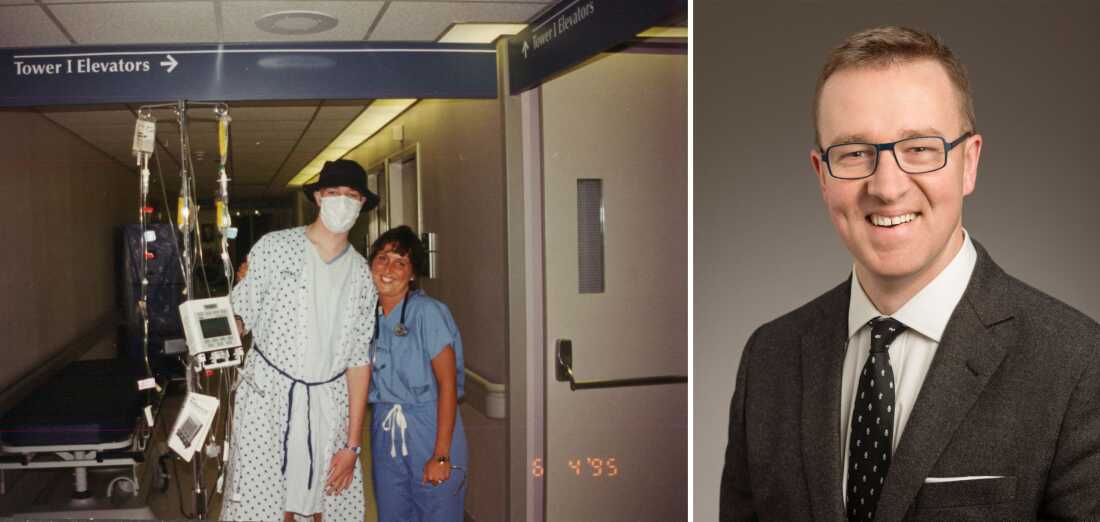
On May 5, 1995, at age 17, Brendan Harley was diagnosed with leukemia. The following day, he started chemotherapy treatments and spent a month on the oncology floor recovering at Brigham and Women’s Hospital in Boston. Now, as a biochemical engineer at the University of Illinois Urbana-Champaign, he’s developing better tumor models that improve targeted treatments
Harley family
hide caption
toggle caption
Harley family
But, says Harley, returning home after feeling so vulnerable made him more determined to live, fully. Driving home from the hospital with the trees having reached full bloom in his absence, he appreciated the vibrancy of color with fresh eyes – and saw his own life in the same light. “It was like I saw it for the first time; I’ve made it back,” he says. “To this day, I can’t forget.”
Vocations forged by experience
Three decades later, Harley’s cancer-free and a father of two. He now fights cancer on a different front. As a biochemical engineer at the University of Illinois Urbana-Champaign, he’s developing better tumor models that help improve targeted treatments to both kill cancer and improve the quality of life afterward. Harley says the cause of his own leukemia may be the earlier radiation and chemotherapy treatments he received at age 1, when he was diagnosed with a neuroblastoma. “How can I make it so that the next generation goes through something different?” he says of his career in cancer research.
Personalizing treatments can help avoid some of the harsher alternatives. “This idea of taking cells from a patient and turning them into a cure…that’s something that is incredibly motivating,” he says.
Meanwhile, EJ Beck is on her own revenge tour against cancer. This fall, she started medical school at NYU Langone, the very hospital where she’d received treatment as a 10 year old. Walking through the same doors as a physician in training felt like the bookend that made her whole life story make sense. “I almost feel like I can see the younger version of myself standing next to me in such a different place in her life,” Beck says.
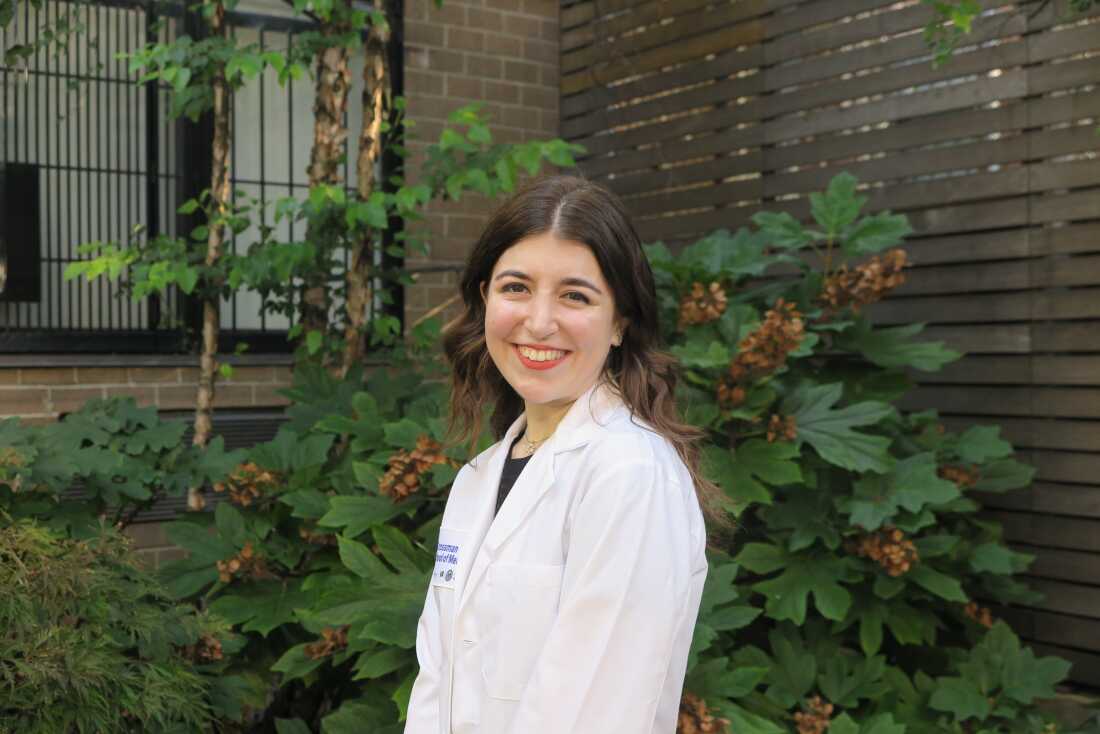
EJ Beck is now pursuing a medical degree at the same hospital complex where she received treatment as a child. “Sometimes it feels as though I’ve lived lifetimes since then, and it hurts to think about,” she says “But mostly they just make me feel immense gratitude for where I am now – I’m incredibly blessed.”
Beck family
hide caption
toggle caption
Beck family
What cancer stole from her childhood, she’s now reclaiming. “It was extremely identity-forming to me. It helped me understand people’s pain more and gave me a mission that I’ve carried with me in life to become a physician who gives back to a field that’s given me so much.”
Original photography by José A. Alvarado Jr. Visuals design and editing by Katie Hayes Luke.
Audio and digital story edited by Diane Webber.

News
Explosion at a Pennsylvania nursing home kills at least 2, governor says

First responders work at the scene of an explosion and fire at Bristol Health & Rehab Center on Tuesday in Bristol, Pa.
Monica Herndon/The Philadelphia Inquirer/AP
hide caption
toggle caption
Monica Herndon/The Philadelphia Inquirer/AP
BRISTOL, Pa. — A thunderous explosion Tuesday at a nursing home just outside Philadelphia killed at least two people, collapsed part of the building, sent fire shooting out and left people trapped inside, authorities said.
Pennsylvania Gov. Josh Shapiro said in a news conference several hours after the explosion that at least two had been killed after emergency responders braved the flames and a heavy odor of gas to evacuate residents and employees.
Fire officials said they were in “rescue mode” five hours later, with responders still digging by hand and using search dogs and sonar to locate potential victims.
The explosion happened at Bristol Health & Rehab Center in Bristol Township, just as a utility crew had been on site looking for a gas leak.
A plume of black smoke rose from the nursing home, as emergency responders, fire trucks and ambulances from across the region rushed there, joined by earthmoving equipment.
Authorities did not identify those who died and did not know the total number of those injured after residents and employees were evacuated to hospitals.
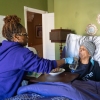
Shapiro asked his fellow Pennsylvanians to take a moment to pray “for this community, for those who are still missing, for those who are injured, and for those families who are about to celebrate Christmas with an empty chair at their table.”
The town’s fire chief, Kevin Dippolito, said at the Tuesday evening news conference that there were five people still unaccounted for, but he cautioned that some may have left the scene with family members.
Dippolito described a chaotic rescue where firefighters found people stuck in stairwells and elevator shafts, and pulled residents out of the fiery building through windows and doors.
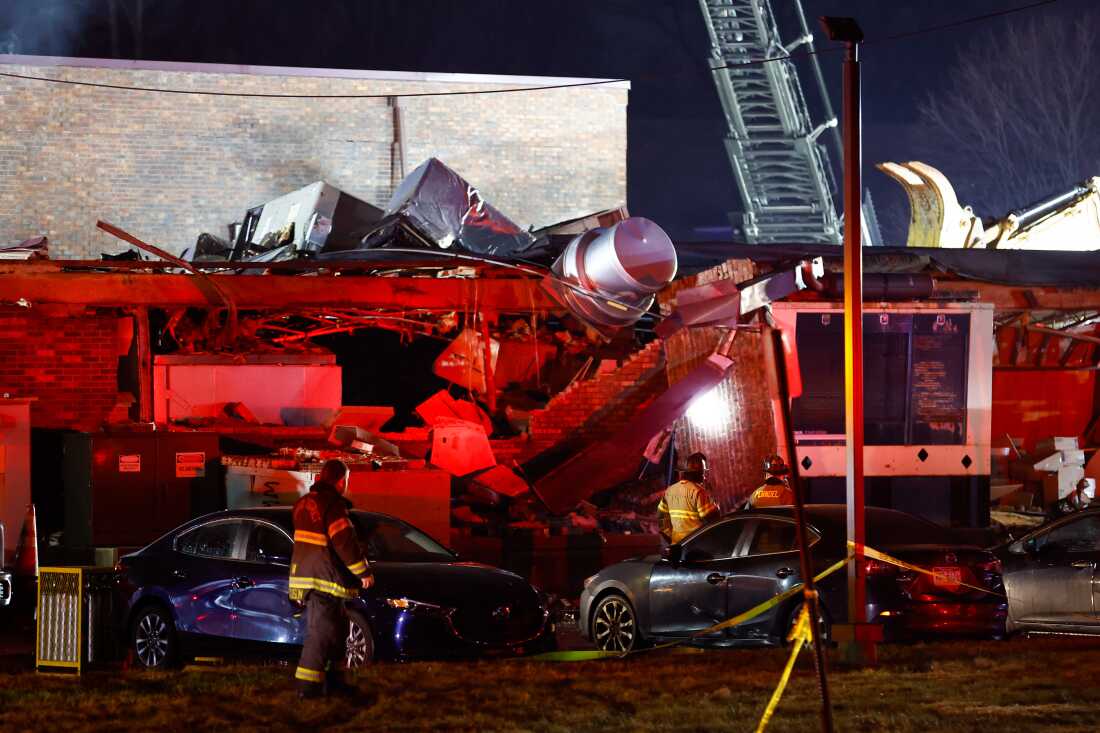
Emergency personnel work at the scene of an explosion and fire at Bristol Health & Rehab Center on Tuesday in Bristol, Pa.
Monica Herndon/The Philadelphia Inquirer/AP
hide caption
toggle caption
Monica Herndon/The Philadelphia Inquirer/AP
They handed off patients to waiting police officers outside, including one “who literally threw two people over his shoulders,” Dippolito said. “It was nothing short of extraordinary.”
Bucks County emergency management officials said they received the report of an explosion at approximately 2:17 p.m. and said a portion of the building was reported to have collapsed.
Willie Tye, who lives about a block away, said he was sitting at home watching a basketball game on TV when he heard a “loud kaboom.”
“I thought an airplane or something came and fell on my house,” Tye said.
He got up to go look and saw “fire everywhere” and people escaping the building. The explosion looked like it happened in the kitchen area of the nursing home, he said. Tye said some of the people who live or work there didn’t make it out.
“Just got to keep praying for them,” Tye said.
Shapiro said a finding that the gas leak caused the explosion was preliminary.
The local gas utility, PECO, said its crews had responded to reports of a gas odor at the nursing home shortly after 2 p.m.
“While crews were on site, an explosion occurred at the facility. PECO crews shut off natural gas and electric service to the facility to ensure the safety of first responders and local residents,” the utility said in a statement.
Nils Hagen-Frederiksen, press secretary at the Pennsylvania Public Utility Commission, said investigators from the safety division were headed to the scene. Finding that the explosion was caused by a gas leak won’t be confirmed until his agency can examine the scene up close, he said.
Musuline Watson, who said she was a certified nursing assistant the facility, told WPVI-TV/ABC 6 that, over the weekend, she and others there smelled gas, but “there was no heat in the room, so we didn’t take it to be anything.”
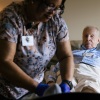

The 174-bed nursing home is about 20 miles (32 kilometers) northeast of Philadelphia. Its owner, Saber Healthcare Group, said it was working with local emergency authorities. The facility had been known until recently as Silver Lake Healthcare Center.
The latest state inspection report for the facility was in October and the Pennsylvania Department of Health found that it was not in compliance with several state regulations.
The inspection report said the facility failed to provide an accurate set of floor plans and to properly maintain several stairways, including storing multiple paint buckets and a bed frame under landings.
It also said the facility failed to maintain portable fire extinguishers on one of the three levels and failed to provide the required “smoke barrier partitions,” which are designed to contain smoke on two floors. It also said it didn’t properly store oxygen cylinders on two of three floors.
According to Medicare.gov, the facility underwent a standard fire safety inspection in September 2024, during which no citations were issued. But Medicare’s overall rating of the facility is listed as “much below average,” with poor ratings for health inspections in particular.
News
BBC Verify: Satellite image shows tanker seized by US near Venezuela is now off Texas

Trump was listed as a passenger on eight flights on Epstein’s private jet, according to emailpublished at 11:58 GMT
Anthony Reuben
BBC Verify senior journalist
One of the Epstein documents, external is an email saying that “Donald Trump traveled on Epstein’s private jet many more times than previously has been reported (or that we were aware)”.
The email was sent on 7 January 2020 and is part of an email chain which includes the subject heading ‘RE: Epstein flight records’.
The sender and recipient are redacted but at the bottom of the email is a signature for an assistant US attorney in the Southern District of New York – with the name redacted.
The email states: “He is listed as a passenger on at least eight flights between 1993 and 1996, including at least four flights on which Maxwell was also present. He is listed as having traveled with, among others and at various times, Marla Maples, his daughter Tiffany, and his son Eric”.
“On one flight in 1993, he and Epstein are the only two listed passengers; on another, the only three passengers are Epstein, Trump, and then-20-year-old” – with the person’s name redacted.
It goes on: “On two other flights, two of the passengers, respectively, were women who would be possible witnesses in a Maxwell case”.
In 2022, Ghislaine Maxwell was sentenced to 20 years in prison, external for crimes including conspiracy to entice minors to travel to engage in illegal sex acts and sex trafficking of a minor.
Trump was a friend of Epstein’s for years, but the president has said they fell out in about 2004, years before Epstein was first arrested. Trump has consistently denied any wrongdoing in relation to Epstein and his presence on the flights does not indicate wrongdoing.
We have contacted the White House for a response to this particular file.
News
‘Music makes everything better’: A Texas doctor spins vinyl to give patients relief

Dr. Tyler Jorgensen sets “A Charlie Brown Christmas” on a record player at Dell Seton Medical Center in Austin Texas. He uses vinyl records as a form of music therapy for palliative care patients.
Lorianne Willett/KUT News
hide caption
toggle caption
Lorianne Willett/KUT News
AUSTIN, TEXAS — Lying in her bed at Dell Seton Medical Center at the University of Texas at Austin, 64-year-old Pamela Mansfield sways her feet to the rhythm of George Jones’ “She Thinks I Still Care.” Mansfield is still recovering much of her mobility after a recent neck surgery, but she finds a way to move to the music floating from a record player that was wheeled into her room.
“Seems to be the worst part is the stiffness in my ankles and the no feeling in the hands,” she says. “But music makes everything better.”
The record player is courtesy of the ATX-VINyL program, a project dreamed up by Dr. Tyler Jorgensen to bring music to the bedside of patients dealing with difficult diagnoses and treatments. He collaborates with a team of volunteers who wheel the player on a cart to patients’ rooms, along with a selection of records in their favorite genres.
“I think of this record player as a time machine,” he said. “You know, something starts spinning — an old, familiar song on a record player — and now you’re back at home, you’re out of the hospital, you’re with your family, you’re with your loved ones.”

Daniela Vargas, a volunteer for the ATX-VINyL program, wheels a record player to the hospital room of a palliative care patient in Austin, Texas.
Lorianne Willett/KUT News
hide caption
toggle caption
Lorianne Willett/KUT News
The healing power of Country music… and Thin Lizzy
Mansfield wanted to hear country music: Willie Nelson, Merle Haggard, George Jones. That genre reminds her of listening to records with her parents, who helped form her taste in music. Almost as soon as the first record spins, she starts cracking jokes.
“I have great taste in music. Men, on the other hand … ehhh. I think my picker’s broken,” she says.
Other patients ask for jazz, R&B or holiday records.
The man who gave Jorgensen the idea for ATX-VINyL loved classic rock. That was around three years ago, when Jorgensen, a long-time emergency medicine physician, began a fellowship in palliative care — a specialty aimed at improving quality of life for people with serious conditions, including terminal illnesses.
Shortly after he began the fellowship, he says he struggled to connect with a particular patient.
“I couldn’t draw this man out, and I felt like he was really struggling and suffering,” Jorgensen said.
He had the idea to try playing the patient some music.
He went with “The Boys Are Back in Town,” by the 1970s Irish rock group Thin Lizzy, and saw an immediate change in the patient.
“He was telling me old stories about his life. He was getting more honest and vulnerable about the health challenges he was facing,” Jorgensen said. “And it just struck me that all this time I’ve been practicing medicine, there’s such a powerful tool that is almost universal to the human experience, which is music, and I’ve never tapped into it.”

Dr. Tyler Jorgensen plays vinyl records as a form of music therapy for palliative care patients in Austin, Texas. Willie Nelson’s albums are a perennial hit.
Lorianne Willett/KUT News
hide caption
toggle caption
Lorianne Willett/KUT News
Creating new memories
Jorgensen realized records could lift the spirits of patients dealing with heavy circumstances in hospital spaces that are often aesthetically bare. And he thought vinyl would offer a more personal touch than streaming a digital track through a smartphone or speaker.
“There’s just something inherently warm about the friction of a record — the pops, the scratches,” he said. “It sort of resonates through the wooden record player, and it just feels different.”
Since then, he has built up a collection of 60 records and counting at the hospital. The most-requested album, by a landslide, is Fleetwood Mac’s Rumours from 1977. Willie is also popular, along with Etta James and John Denver. And around the holidays, the Vince Guaraldi Trio’s A Charlie Brown Christmas gets a lot of spins.
These days, it’s often a volunteer who rolls the record player from room to room after consulting nursing staff about patients and family members who are struggling and could use a visit.
Daniela Vargas, the UT Austin pre-med undergraduate who heads up the volunteer cohort, became passionate about music therapy years ago when she and her sister began playing violin for isolated patients during the COVID-19 pandemic. She said she sees similar benefits when she curates a collection of records for a patient today.
“We are usually not in the room for the entire time, so it’s a more intimate experience for the patient or family, but being able to interact with the patient in the beginning and at the end can be really transformative,” Vargas said.
Often, the palliative care patients visited by ATX-VINyL are near the end of life.
Jorgensen feels that the record player provides an interruption of the heaviness those patients and their families are experiencing. Suddenly, it’s possible to create a new, positive shared experience at a profoundly difficult time.
“Now you’re sort of looking at it together and thinking, ‘What are we going to do with this thing? Let’s play something for Mom, let’s play something for Dad.’” he said. “And you are creating a new, positive, shared experience in the setting of something that can otherwise be very sad, very heavy.”
Other patients, like Pamela Mansfield, are working painstakingly toward recovery.
She has had six neck surgeries since April, when she had a serious fall. But on the day she listened to the George Jones album, she had a small victory to celebrate: She stood up for three minutes, a record since her most recent surgery.
With the record spinning, she couldn’t help but think about the victories she’s still pursuing.
“It’s motivating,” she said. “Me and my broom could dance really well to some of this stuff.”
-

 Iowa1 week ago
Iowa1 week agoAddy Brown motivated to step up in Audi Crooks’ absence vs. UNI
-

 Maine1 week ago
Maine1 week agoElementary-aged student killed in school bus crash in southern Maine
-

 Maryland1 week ago
Maryland1 week agoFrigid temperatures to start the week in Maryland
-

 New Mexico7 days ago
New Mexico7 days agoFamily clarifies why they believe missing New Mexico man is dead
-

 South Dakota1 week ago
South Dakota1 week agoNature: Snow in South Dakota
-

 Detroit, MI1 week ago
Detroit, MI1 week ago‘Love being a pedo’: Metro Detroit doctor, attorney, therapist accused in web of child porn chats
-

 Health1 week ago
Health1 week ago‘Aggressive’ new flu variant sweeps globe as doctors warn of severe symptoms
-

 Maine7 days ago
Maine7 days agoFamily in Maine host food pantry for deer | Hand Off
















